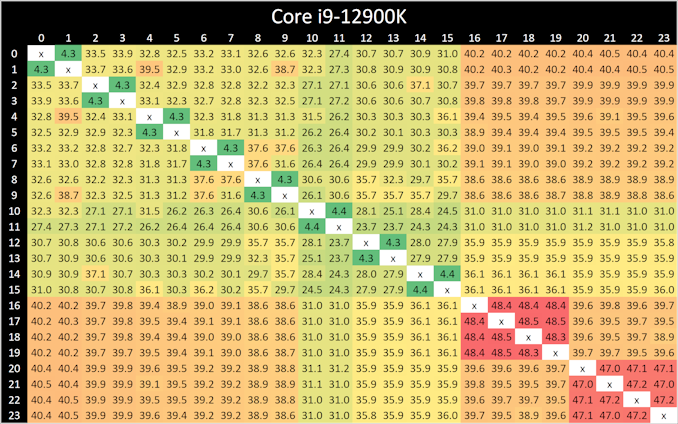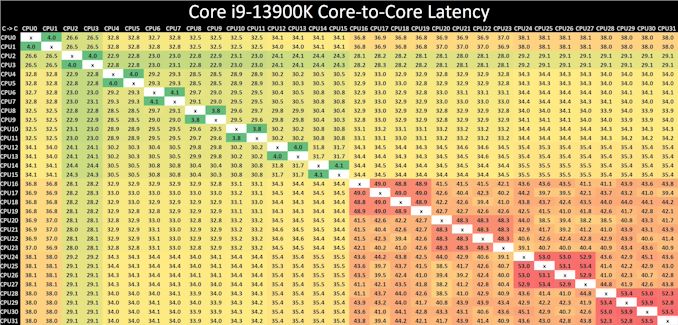Intel Core i9-13900K and i5-13600K Review: Raptor Lake Brings More Bite
by Gavin Bonshor on October 20, 2022 9:00 AM ESTCore-to-Core Latency
As the core count of modern CPUs is growing, we are reaching a time when the time to access each core from a different core is no longer a constant. Even before the advent of heterogeneous SoC designs, processors built on large rings or meshes can have different latencies to access the nearest core compared to the furthest core. This rings true especially in multi-socket server environments.
But modern CPUs, even desktop and consumer CPUs, can have variable access latency to get to another core. For example, in the first generation Threadripper CPUs, we had four chips on the package, each with 8 threads, and each with a different core-to-core latency depending on if it was on-die or off-die. This gets more complex with products like Lakefield, which has two different communication buses depending on which core is talking to which.
If you are a regular reader of AnandTech’s CPU reviews, you will recognize our Core-to-Core latency test. It’s a great way to show exactly how groups of cores are laid out on the silicon. This is a custom in-house test, and we know there are competing tests out there, but we feel ours is the most accurate to how quick an access between two cores can happen.

Looking at core-to-core latencies going from Alder Lake (12th Gen) to Raptor Lake (13th Gen), things look quite similar on the surface. The P-cores are listed within Windows 11 from cores 0 to 15, and in comparison to Alder Lake, latencies are much the same as what we saw when we reviewed the Core i9-12900K last year. The same comments apply here as with the Core i9-12900K, as we again see more of a bi-directional cache coherence.
Latencies between each Raptor Cove core have actually improved when compared to the Golden Cove cores on Alder Lake from 4.3/4.4 ns, down to 3.8/4.1 ns per each L1 access point.
The biggest difference is the doubling of the E-cores (Gracemont) on the Core i9-13900K, which as a consequence, adds more paths and crossovers. These paths do come with a harsher latency penalty than we saw with the Core i9-12900K, with latencies around the E-cores ranging from 48 to 54 ns within four core jumps between them; this is actually slower than it was on Alder Lake.
One possible reason for the negative latency is the 200 MHz reduction in base frequency on the Gracemont cores on Raptor Lake when compared with Alder Lake. When each E-core (Gracemont) core is communicating with each other, they travel through the L2 cache clusters via the L3 cache ring and back again, which does seem quite an inefficient way to go.











169 Comments
View All Comments
blppt - Monday, October 24, 2022 - link
Wow, what is going on with Civ 5 and Intel 12/13 series CPUs? They get absolutely wrecked. Replyshoestring - Tuesday, October 25, 2022 - link
"...eeking out every last bit of performance" +1 for word choice, -1 for the spelling: it's actually "eking", which looks weird to me too! https://www.dictionary.com/browse/eke ReplyRyan Smith - Tuesday, October 25, 2022 - link
You are correct. The article has been fixed.I humbly accept my deduction in points. Thank you for bringing it to my attention. Reply
OreoCookie - Tuesday, October 25, 2022 - link
I am surprised Gavin did not include the cooler and perhaps beefier power supply in the price comparison: clearly, if you get an Intel system, you need a *much* bigger cooler, especially if you care about noise. And you might need a bigger power supply, especially if you plan on getting an nVidia 4000-series card. Replynader_21007 - Wednesday, November 2, 2022 - link
THX for the review.It should be mentioned that INTEL's 13900K is nowhere near the MSRP of $589, I expect the writer to check the real prices, it's price is $795, about $100 more than AMD's ryzen 7950X.
AMD CPU's are cheaper. it's FACT. Reply
SanX - Wednesday, November 9, 2022 - link
I do not need your bs E cores in desktop, Intel ReplySantoval - Tuesday, November 22, 2022 - link
I wonder if the 5.8 GHz turbo is going to last more than 1 nanosecond at a time. ReplyVVTF - Tuesday, October 17, 2023 - link
The sad thing is, I find this Alder Lake-N review for Nuc Boxes on Anadtech much more interesting:https://www.anandtech.com/show/21085/asrock-indust... Reply